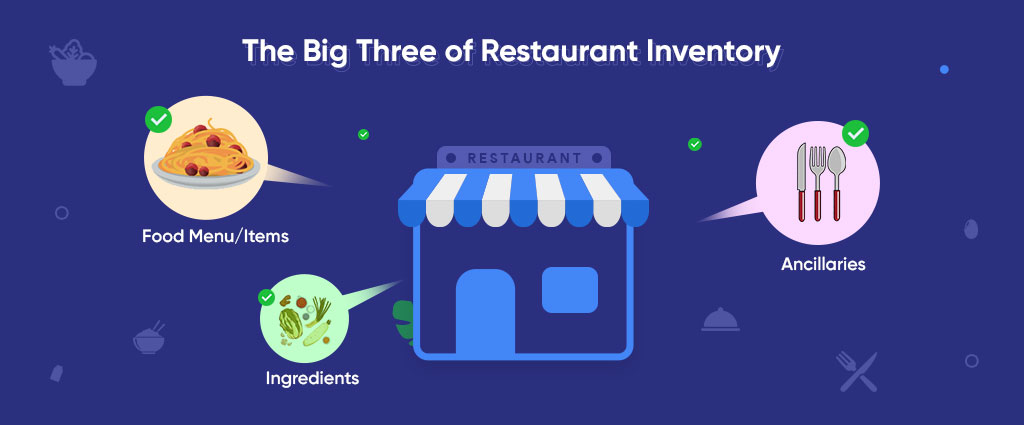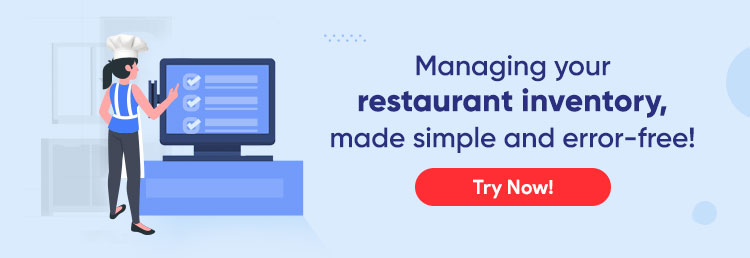
In India, 40% of food prepared is wasted, with an average Indian wasting 137 grams of food every single day. Some of them are probably dining at your restaurant at this very moment! You wish to reduce costs. But due to improper restaurant inventory management, 60% of restaurants, like yours, shut shop before their first birthday. Most of the rest drop the curtain within their fifth birthday.
Long story short, adopting restaurant inventory management is inevitable!
What is restaurant inventory management?
Restaurant inventory management consists of the processes and practices of tracking your restaurant inventory, monitoring the quantity and usage, and controlling the discrepancies and variances. Simply put, it is the optimized end-to-end management of your restaurant’s inventory. As a restaurateur, you must always be aware of the following terms for ensuring efficient restaurant inventory management:
- Purchases: The inventory you have purchased on a particular day
- Usage: The inventory you have used on a particular day
- Ending inventory: The inventory remaining at the end of that particular day
Benefits of managing your restaurant inventory
Prevention of theft or pilferage
Around 75% of restaurant employees across the globe have committed theft at least once, and this impacts the business bottom line. Managing restaurant inventory effectively helps in preventing pilferage of ingredients and cutlery.
Improved wastage management
Improper tracking of ingredient quantity and freshness, incorrect recipe formulations, and wrong preparation methods for menu items can lead to wastage of inventory. A good restaurant inventory management module helps mitigate all the above mentioned errors.
Better supplier relationships
With ingredient quantities being forecasted with the utmost precision, you will be able to communicate better with your suppliers regarding your requirements. Aside from building good relationships, this will also help you reduce acquisition costs.
Better forecasting of food costs
Food costs form the major chunk of a restaurant’s expenditure. With a good recipe management system on your restaurant POS software, you will be able to map the ingredient quantities portion-wise – resulting in discerning accurate food costs.
Optimal menu pricing
With your ingredients being monitored meticulously, and your food costs determined accurately, you will be able to price your menu items at the optimal value – striking a balance between attracting customers and generating profits.
Higher investment potential
Managing restaurant inventory efficiently leads to lesser costs and more profits, that is, there is a sustainable cash inflow. With improved earnings, you can invest in various aspects of your restaurant, such as hiring more staff, improving the ambiance, etc.
Lesser customer dissatisfaction
Imagine this: A top customer of yours walks into your restaurant, and orders a plate of Paneer Butter Masala – and as if on cue, your chef informs you that there is no Paneer left in the inventory. You walk back to your customer bearing this bad news – turning that smile into a disappointing frown. Could you make sure this incident doesn’t happen again? Of course you can! By installing an accurate restaurant inventory management system, you’ll be alerted whenever the ingredient stock hits the safety stock levels. With this fix, you’ll ensure no dish is ever 86’d.
The Big Three of Restaurant Inventory

Lord Brahma, Lord Vishnu and Lord Shiva. Ranchcho, Raju, and Farhan. Amar, Akbar, and Anthony. Iron Man, Captain America, and Thor. Notice the similarities? You got it – they all constitute a terrific trio. The number three is a symbol of strength and stability. Even the fundamental unit of living, i.e. the atom, is made up of 3 components – protons, neutrons, and electrons.
Similarly, your restaurant inventory is made of the 3 most important components, which are:
Food (or) menu items inventory
This inventory consists of the menu items that you prepare in a central kitchen, the ones you have readily available, and the ones that you make in-situ at the restaurant.
Ingredient inventory
This is the most important type of inventory – for the dishes that you prepare at the restaurant are dependent on how well you have stocked up on the essential ingredients. Monitoring their quantity and freshness is crucial for success.
Ancillaries inventory
This consists of inventory other than food items and ingredients – like your cutlery, trade-as-is items like ketchup sachets, salt-and-pepper cans, and so on. Keeping a check on the ancillary items is also important for a holistic restaurant inventory management.
The Restaurant Inventory Management Checklist
Here is an exhaustive checklist that you can adopt to plan your purchases, monitor your stock, and track your consumption and wastage. This checklist contains five modules, each pertaining to an aspect of restaurant inventory management:
1. Shelf Management
Shelf management refers to how you manage your ingredients and menu items, which form the backbone of your restaurant’s inventory. Here are a few good shelf management techniques that you can adopt:
- Categorize and organize your ingredients carefully. For example, you can divide your ingredient stock into fresh produce, cold cuts (meat) & eggs, dairy, etc.
- Arrange your ingredients based on their purchase date and freshness. While some ingredients like flour, sugar, and salt have a longer shelf life, there are a few others which are perishable, like milk, fruits, and vegetables.
- Label your shelves properly. This will help in the prevention of human errors such as improper storage and double counting.
- Assign a unique inventory ID for each of your ingredients. This will help in identifying the right order quantity and avoiding confusions while stock taking.
2. Consumption Management
Consumption management is another important aspect of managing your restaurant inventory. You must understand a few terminologies before delving deep into consumption management:
- Current inventory: Also called as sitting inventory, this is the amount (measured either in rupee value or in the appropriate units) of inventory that a restaurant is carrying at a specific timeframe.
- Consumption: Consumption is the amount of restaurant inventory that is used within a specific timeframe.
- Utilization: Utilization is the ratio between the current inventory to consumption over a specific time frame.
- Variance: Variance is the difference between utilization and actual sales made. For example, during a week, if you used bread worth ₹ 500, but your restaurant POS reports show that you sold only ₹ 475, you have a negative variance of ₹ 25.
- Yield: Yield is the ratio between the amount of a product sold to the amount utilized for making the product. For example, if you used 1 kg of flour to make chapattis, and your POS reports show a sale quantity of 850 g, your yield is calculated as 0.85 or 85%.
Once you understand these terms, create restaurant inventory spreadsheets to track the quantity and consumption of all your ingredients. For each ingredient, you can monitor the following information:
- Ingredient ID
- Category
- Ingredient Name
- Unit of Measurement (UOM)
- Conversion UOM
- Cost per UOM
- Amount of ingredient used
- Beginning inventory
- Ending inventory
- Total usage cost
- Wastage quantity
- Wastage cost
3. Stock Management
Stock management refers to the effective storage and usage of your ingredients. Some of the best practices in stock management are:
- Practice minimal inventory stocking. This helps in reducing your inventory carrying costs and the costs incurred due to wastage or spoilage.
- Adopt a first-in, first-out (FIFO) inventory usage for your restaurant. As mentioned earlier, some ingredients have a shorter shelf life and they must be used first.
- Employ seasonal stocking. There are a few ingredients which are available abundantly during certain seasons, e.g. mangoes during summers in India. By identifying such seasonal ingredients, you will be able to reduce your restaurant inventory costs.
- Calculate safety stock levels for each ingredient. This will ensure that your reorder quantity and date of reorder is synced based on the stock availability.
4. Recipe Management
A proper recipe management system helps you measure the right quantities of ingredients based on portion sizes. You will also be able to discern the food costs and determine optimal menu pricing. It is recommended that you create a spreadsheet to keep track of the following metrics:
- Ingredient name
- Grade of quality
- Purchase cost
- Yield percentage
- Total cost of the recipe
- Selling price
- Food cost percentage
5. Staff Management
Finally, you must allocate a staff panel for restaurant inventory management. Assign a stock-taking team for receiving the purchased stock and updating the inventory records.
How does Gofrugal’s Restaurant POS software help you manage your inventory?
Gofrugal’s Restaurant POS software has dedicated restaurant inventory management features that will guide you on the path towards profitable growth. Here are 7 features that make Gofrugal’s Restaurant POS software the best option for your restaurant:
- Recipe management feature with unit of measurement (UOM) conversions and 3-decimal precision to track consumption accurately
- Physical stock update feature with approval mechanism to detect any discrepancies in stock taking
- Automatic reorder quantity & date detection to avoid unprecedented inventory shortages
- Wastage monitoring mechanism which determines the exact type of wastage to help you minimize the costs incurred
- Intuitive food cost calculator for determining the best menu pricing and improve profitability
- Simple user interface that requires the least training and minimal skills to operate
- 80+ reports with empirical insights to implement data-driven decision making
Restaurant inventory management is your vaccine against low productivity. The radiant lighthouse that will guide your ship through the choppy waters of uncertainty. With proper planning, conscious efforts, and an efficient restaurant POS software to automate your operations – you will be able to witness an increase in productivity, decline in purchase costs and inventory wastage, and improved customer satisfaction.
Adopt the restaurant inventory management checklist now, and witness your business flourish and rise above!
